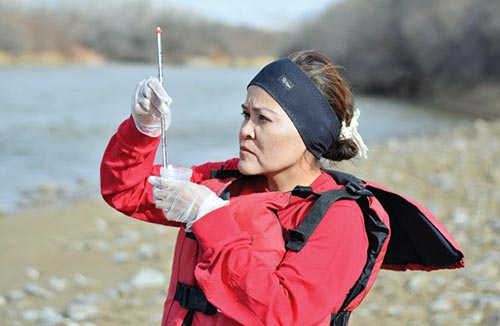
‘We have to think like our ancestors’

Navajo Times | Donovan Quintero Karletta Chief, an extension specialist with the University of Arizona’s Soil, Water & Environmental Science Center for Environmental Physics & Mineralogy, reads the results of the types of contaminants found in the San Juan River on Monday near Shiprock.
Experts say healing will not come easy after toxic mine spill

Navajo Times | Donovan Quintero
Karletta Chief, an extension specialist with the University of Arizona’s Soil, Water & Environmental Science Center for Environmental Physics & Mineralogy, reads the results of the types of contaminants found in the San Juan River on Monday near Shiprock.
SHIPROCK, N.M.
Seven months after U.S. Environmental Protection Agency crews accidentally released three million gallons of toxic waste into the Animas and San Juan rivers, Navajo residents still are waiting for their lives – and livelihoods – to be made whole again.
But healing may not come, said Becky Clauson, a sociology professor at Fort Lewis College. At least, not in the way those residents most adversely impacted by the spill are hoping.
“It’s not just about the data or the testing,” Clauson told a group of concerned farmers, ranchers and residents gathered Saturday at the Shiprock Youth Complex. “It’s what’s going on inside when you see your river turn yellow or hear that you can’t water your crops.”
Clauson was one of several presenters during a teach-in session hosted by To Bei Nihi Dziil’, a community-based coalition formed in the aftermath of the Gold King Mine spill last August.

Navajo Times | Donovan Quintero
Volunteer John Hosteen, rows the raft on the San Juan River Monday evening as Shiprock towers over the trees near Shiprock.
The spill, which occurred at an abandoned mine near Silverton, Colo., sent a plume of orange toxins downstream, contaminating water, soil and sediment and affecting the livelihoods of thousands of Navajos who depend on the river.
Clauson, a member of the Animas Community Listening and Empowering Project, told a group of about 50 people that healing may need to come from within the community. When natural disasters hit communities, people tend to pull together, she said. But when environmental disasters strike, communities fall apart.
“Are social relationships becoming contaminated with hostility?” she asked. “Are you feeling sadness? Grief? Loss?”
To read the full article, pick up your copy of the Navajo Times at your nearest newsstand Thursday mornings!
Are you a digital subscriber? Read the most recent three weeks of stories by logging in to your online account.







 Highway 264,
Highway 264, I-40, WB @ Winslow
I-40, WB @ Winslow